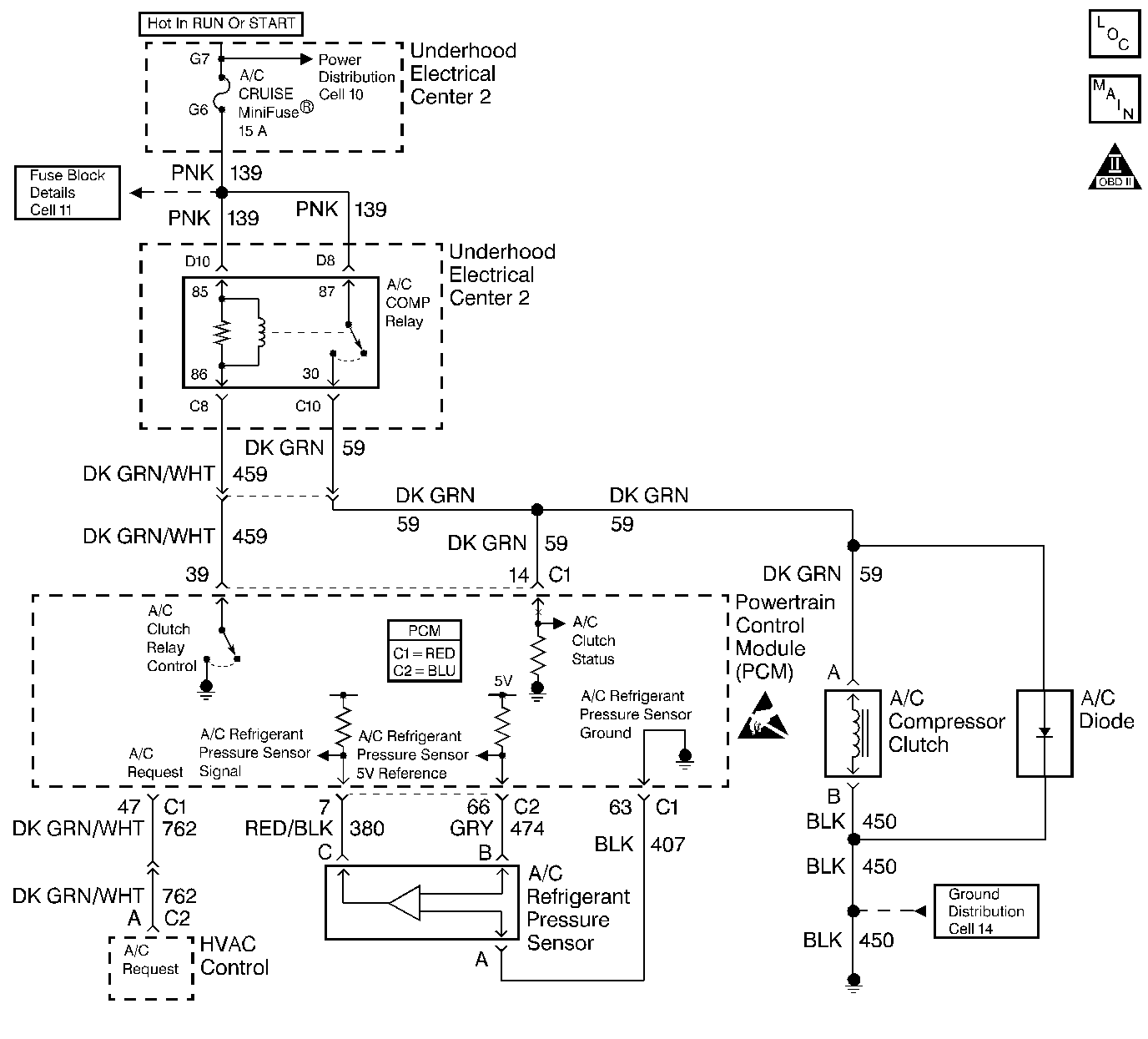
Circuit Description
The A/C system uses an A/C refrigerant pressure sensor mounted in the high side of the A/C system to monitor A/C refrigerant pressure. The PCM utilizes this information in order to turn ON the engine coolant fans when the A/C refrigerant pressure is high.
The A/C refrigerant pressure sensor operates much like other 3-wire sensors. The PCM supplies a 5.0 volt reference to the sensor. The sensor supplies a signal circuit to the PCM. As the A/C pressure increases or decreases, the resistance of the sensor changes and varies the amount of signal returning to the PCM.
The PCM monitors the A/C refrigerant pressure sensor signal circuit and can determine when the A/C pressure is too high or too low. The PCM disables the A/C compressor clutch and sets a DTC P0530 when the pressures are out of range (high or low) for a predetermined time. The PCM disables the A/C compressor in order to prevent A/C compressor damage.
Conditions for Running the DTC
The PCM detects an A/C request.
Conditions for Setting the DTC
A/C refrigerant pressure sensor indicates A/C refrigerant pressure is below 3.0 psi for 5.0 seconds.
OR
A/C refrigerant pressure sensor indicates A/C refrigerant pressure is above 445 psi for 5.0 seconds.
Action Taken When the DTC Sets
| • | The powertrain control module (PCM) stores the DTC information into memory when the diagnostic runs and fails. |
| • | The malfunction indicator lamp (MIL) will not illuminate. |
| • | The PCM records the operating conditions at the time the diagnostic fails. The PCM stores this information in the Failure Records. |
Conditions for Clearing the DTC
| • | A last test failed, or current DTC, clears when the diagnostic runs and does not fail. |
| • | A history DTC will clear after 40 consecutive warm-up cycles, if no failures are reported by this or any other non-emission related diagnostic. |
| • | Use a scan tool in order to clear the DTC. |
Diagnostic Aids
If the test did not fail this ignition cycle, move the related electrical harnesses and the connectors while monitoring a scan tool.
For an intermittent, refer to Symptoms .
Test Description
The numbers below refer to the step numbers on the diagnostic table.
-
The normal A/C voltage is between 1.0 and 1.8 volts. If the A/C voltage is within the range, review the freeze frame data in order to determine when the DTC P0530 set.
-
If the A/C pressure/voltage stays high after disconnecting the A/C refrigerant pressure sensor electrical connector, this indicates the signal circuit is shorted to a voltage.
-
This step tests for a good ground circuit.
-
This step tests the integrity of the A/C refrigerant pressure sensor signal circuit.
-
If you have thoroughly tested the 5.0 volt reference circuit (for opens, shorts to ground, PCM connections etc.) and the circuit tests OK, then replace the PCM.
-
If you have thoroughly tested the ground circuit for opens and the PCM connections are OK, then replace the PCM.
Step | Action | Value(s) | Yes | No |
|---|---|---|---|---|
1 | Did you perform the Powertrain On-Board Diagnostic (OBD) System Check? | -- | ||
2 |
Did DTC P1635 Fail This Ignition cycle? | -- | ||
Does the scan tool indicate the A/C High Side between the specified range? | 0.1-1.8V | |||
4 |
Does the scan tool indicate that this diagnostic failed this ignition? | -- | Go to Diagnostic Aids | |
Disconnect the A/C refrigerant pressure sensor electrical connector. Does the scan tool indicate the A/C High Side less than the specified value? | 1.0V | |||
6 | Measure the voltage from the A/C refrigerant pressure sensor 5.0 volt reference circuit to the battery ground using the DMM J 39200 . Is the voltage near the specified value? | 5.0V | ||
Measure the voltage from the A/C refrigerant pressure sensor 5.0 volt reference circuit to the sensor ground circuit using the DMM J 39200 . Is the voltage at the specified value? | 5.0V | |||
Jumper the 5.0 volt reference circuit to the A/C refrigerant pressure sensor signal circuit using a fused jumper wire. Refer to Using Fused Jumper Wires in Wiring Systems. Does the scan tool indicate the A/C High Side voltage at the specified value? | 5.0V | |||
9 | Repair the faulty A/C refrigerant pressure sensor connection or faulty sensor. Refer to Air Conditioning (A/C) Refrigerant Pressure Sensor Replacement in HVAC Manual. Is the action complete? | -- | -- | |
10 | Repair the short to voltage in the A/C refrigerant pressure sensor signal circuit. Refer to Wiring Repairs in Wiring Systems. Is the action complete? | -- | -- | |
Repair the 5.0 volt reference circuit to the A/C refrigerant pressure sensor. Refer to Wiring Repairs in Wiring Systems. Is the action complete? | -- | -- | ||
Repair the ground circuit to the A/C refrigerant pressure sensor. Refer to Wiring Repairs in Wiring Systems. Is the action complete? | -- | -- | ||
13 | Repair the signal circuit to the A/C refrigerant pressure sensor. Refer to Wiring Repairs in Wiring Systems. Is the action complete? | -- | -- | |
14 |
Does the scan tool indicate that this test ran and passed? | -- | ||
15 | Select the Capture Info option and the Review Info option using the scan tool. Does the scan tool display any DTCs that you have not diagnosed? | -- | Go to the applicable DTC table | System OK |
